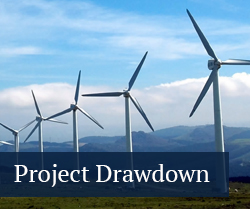Sector Topics
Electricity Generation
The Electricity Generation sector currently accounts for around 40 percent of annual greenhouse gas emissions to the atmosphere, making it the highest-emitting sector in the world. Of total worldwide electricity generation, fossil fuels represent 67 percent, nuclear 11 percent, and renewable energy sources just over 24 percent and growing. In the last few years, however, the competitiveness of renewable sources for electricity generation has continued to increase due to the price evolution and the efficiency improvements of these technologies.
Project Drawdown’s Electricity Generation Sector includes both solutions for electricity generation and enabling technologies that foster large-scale integration of renewable energy sources.
Food
The essential human activity of eating is responsible for a major share of greenhouse gas emissions today: crop and livestock production is the source of about ⅛ of anthropogenic emissions. Land clearing (which is mostly for agriculture) is the source of another ⅛ of emissions.
Project Drawdown’s Food Sector includes agricultural production (crops and livestock) as well as food preparation, consumption, and waste. Many of the supply-side agricultural solutions reduce emissions from farming and ranching, while also sequestering significant amounts of carbon. Demand-side solutions like a plant-based diet and reduced food waste reduce the need for land clearing.
Women and Girls
Climate change is not gender neutral. Due to existing inequalities, women and girls are disproportionately vulnerable to its impacts, from disease to natural disaster. At the same time, women and girls are pivotal to addressing global warming successfully — and to humanity’s overall resilience.
Project Drawdown’s Women and Girls Sector is deceptively small in number: its three solutions focus on the majority of humanity, and represent powerful ways to reduce greenhouse gas emissions (combined, educating girls and family planning are the #1 Drawdown solution). These solutions show that enhancing the rights and well-being of women and girls could improve the future of life on this planet.
Buildings and Cities
Dense urban human settlement — the cities of the world and the buildings and infrastructure that comprise them — account for a significant percentage of human energy use, mostly for heating and cooling. Ergo, they are a significant source of greenhouse gas emissions. The rapid urbanization of humanity ushered in inefficient design of buildings and infrastructure.
Project Drawdown’s Buildings and Cities Sector models several solutions that address the operating inefficiencies of dwelling in and using buildings, and of living in cities.
Land Use
Deforestation and degradation of forest ecosystems are responsible for about ⅛ of anthropogenic greenhouse gas emissions today. Land use solutions reduce emissions from deforestation and degradation of ecosystems. Forests, peatlands, and coastal wetlands provide critical ecosystem services as well, while timber and biomass crops produce important feedstocks for construction, paper, energy, and other uses.
Project Drawdown’s Land Use Sector includes the protection and restoration of high-carbon ecosystems such as forests and wetlands, as well as the production of perennial timber and biomass crops.
Transport
Transport produces 7 gigatons of carbon dioxide-equivalent greenhouse gas emissions annually, or 23 percent of energy-related emissions, which is around 14 percent of all emissions. Though some modes of transport can only currently be made more efficient at using existing fossil fuels, others have alternative fuels and/or can be avoided completely using information and communication technologies.
Materials
The most important insight about materials in the twentieth century was biologist John Todd’s, when he coined the phrase “Waste equals food.” That happens to be the exact practice of all living systems, but at the time Todd made his observation, it was in stark contrast to the realities of the manufacturing world. Industry has come a long way since then, with responsible companies now paying close attention to where they source their materials and what happens to them after the useful life of their products. That being said, society is at the very beginning of redesigning and reimagining the materials used in products and structures, as well as the means by which they can be reduced, reused, and recycled. The newest discoveries are not covered here, of course, but this section details the common techniques and technologies critical to the effort to reverse global warming. To underline that fact, the number-one solution is contained within this sector.




